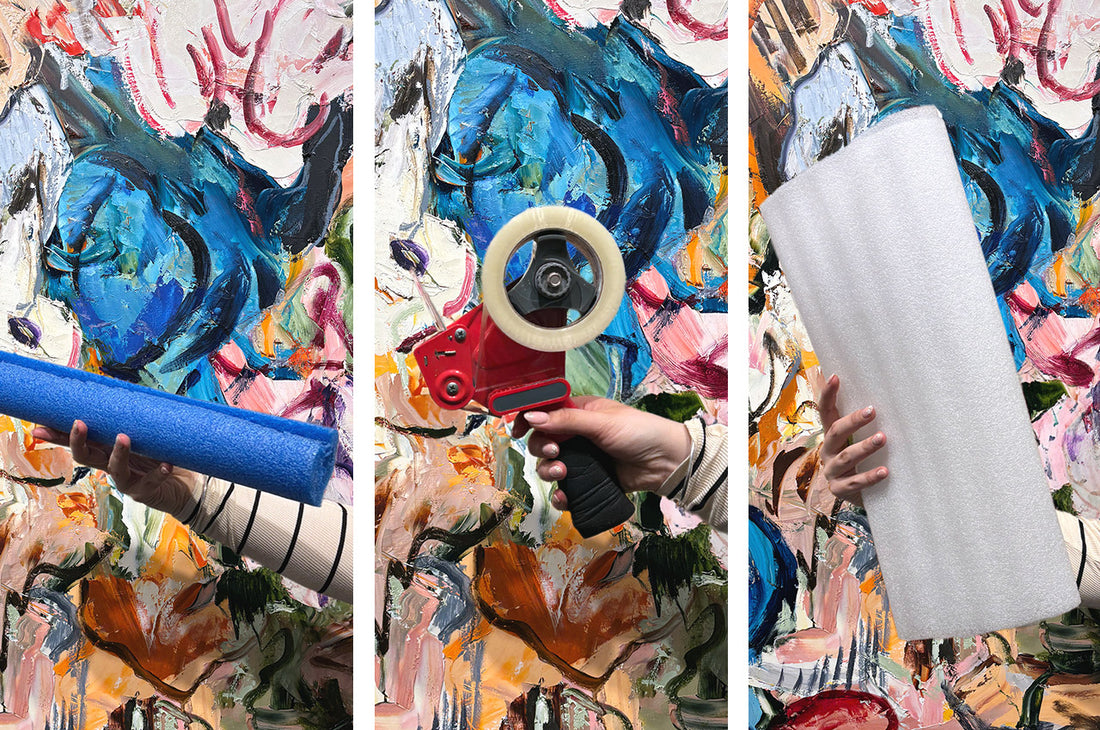You’re facing the challenge of moving or renovating your space soon and you’re concerned about how to transport your cherished artworks safely? We’ve got you covered.
1. Essential Materials
To ensure your artwork is protected during a move or while in storage, you will need:
 - Protective foam: Available at home improvement stores like Home Depot, Rona or Staples, U-Haul, and Uline.
- Protective foam: Available at home improvement stores like Home Depot, Rona or Staples, U-Haul, and Uline.
- Packaging stretch wrap: Find this at Home Depot, Staples, Rona, U-Haul, and Uline.
- Floating pool noodles or foam pipe wraps: These can be useful for cushioning edges and corners, available at hardware stores or Canadian Tire.
- Sturdy cardboard boxes: Appropriately sized for your artwork, available at Uline and U-Haul, or consider using Styrofoam sheets from hardware stores.
- High-quality blue painter's tape: For protecting glass without leaving residue, available at hardware stores.
2. Wrapping and Packing Different Types of Artworks
- Artwork with glass: Start by making an "X" with painter's tape over the glass to prevent shattering (we are a little bit over the top here and tend to prefer making a “*”). Optionally cover with glassine paper and then with protective foam, or use protective foam directly, and secure with tape.

-Canvas artwork: Wrap first in glassine paper and then with protective foam or use protective foam directly. Ensure all sides and corners are covered. Secure the material towards the edges and the back of the artwork to avoid punctures or pressure marks.

For both glass and canvas artworks, if the piece has a frame, protect the corners by cutting pieces of about 8 inches long from a floating pool noodle or foam pipe wrap. Secure them with tape, ensuring the foam does not touch the canvas.

Finally, wrap everything in bubble wrap for additional protection. If bubble wrap is not available, slide the artwork into the cardboard box you've purchased or sandwich it between two Styrofoam panels.

- Sculptures: Preferably wrap in protective foam but not too tightly. Place it in a rigid cardboard box, wooden crate, or plastic bin. Try to secure the base and add soft padding like bubble wrap or memory foam for additional cushioning, ensuring the sculpture has some room to move and absorb potential shocks without being too loose.
3. Common Mistakes and How to Avoid Them
- Not using enough padding, leading to excessive movement and potential damage.
- Using materials that may react if in contact directly with the art, like acidic paper or plastic wrap that adheres to paint.
- Stacking artwork on top of each other, causing cracking or deformation.
Ensure each piece is individually wrapped and secured in its box without any room to shift.
4. Techniques for Ensuring Artwork Stays Secure During Transit
- Place framed pieces upright in the box, as they would hang on a wall.
- Avoid stacking boxes containing artworks.
- Fill all gaps in the box with crumpled packing paper or foam peanuts to prevent movement.
- If using a moving truck, secure artwork boxes against heavy, stable items to avoid sliding or tipping.
5. Tips for Short-Term and Long-Term Storage of Art
- Store artwork in climate-controlled environments to prevent damage from temperature fluctuations or humidity.
- Never store artwork directly on the ground or in damp areas like basements or attics.
- Regularly check stored artwork for signs of damage or deterioration.
By following these guidelines, you can confidently pack and store your artwork safely during moves or renovations, ensuring they remain in pristine condition.
If in doubt, please don’t hesitate to contact us. We are here for you, always.

